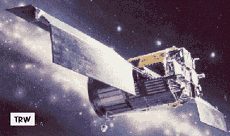TAOS
Technology for Autonomous Operational Survivability
 TAOS is a technology demonstration satellite whose purpose is to demonstrate autonomous space navigation systems to reduce satellite ground support needs. Lowering the needs for ground support of future spacecraft would 1) increase the survivability of satellites during wartime conditions and 2) reduce satellite operations costs. TAOS also incorporates several new satellite bus components designed to improve reliability and maintainability of
future spacecraft while reducing life-cycle costs. TAOS is the first mission flown under the USAF's
STEP (Space Test Experiments Platform) program, and is designated STEP Mission 0. The satellite is controlled from Onizuka AFB, Calif. Satellite operations were interrupted on July 19, 1994 when an inertial measurement unit failed. During the following two month period, the satellite's solar panels could not be properly sun-pointed, resulting in a loss of satellite power. Vehicle control was regained following the development of a new satellite control system.
TAOS is a technology demonstration satellite whose purpose is to demonstrate autonomous space navigation systems to reduce satellite ground support needs. Lowering the needs for ground support of future spacecraft would 1) increase the survivability of satellites during wartime conditions and 2) reduce satellite operations costs. TAOS also incorporates several new satellite bus components designed to improve reliability and maintainability of
future spacecraft while reducing life-cycle costs. TAOS is the first mission flown under the USAF's
STEP (Space Test Experiments Platform) program, and is designated STEP Mission 0. The satellite is controlled from Onizuka AFB, Calif. Satellite operations were interrupted on July 19, 1994 when an inertial measurement unit failed. During the following two month period, the satellite's solar panels could not be properly sun-pointed, resulting in a loss of satellite power. Vehicle control was regained following the development of a new satellite control system.
Spacecraft
3-Axis stabilized. Two solar arrays with 1-axis articulation. Hydrazine propulsion system used for orbit maintenance and to desaturate momentum wheels. S-Band communications link with SGLS
RTS stations. MIL-STD 1553B data bus used for intra-satellite communications. Two MIL-STD 175OA computers used for spacecraft control and payload operation.
Payload
10 experiments to investigate technologies applicable to autonomous space operations. Microcosm Autonomous Navigation System (MANS) used two spinning sensors to provide Earth/Sun/Moon
position measurements to determine satellite position and attitude. The system had a goal of 100 meters in position and 0.03 degrees in attitude. A six-channel Global Positioning System (GPS) receiver was used to calculate orbital position to within several meters. The 1553B data bus and
MIL-STD 175OA computers were carried as technology demonstrations. The satellite also carried a radar sensor and two laser sensors.
| Country of Origin | United States |
| Customer/User | USAF |
| Manufacturer(s) | TRW, Defense Systems Inc. (now CTA) |
| Size | 0.95 m dia. x 1.73 m tall (stowed) |
| Orbit | 538 km, incl. = 105 deg. |
| Design Life | 1 year |
| Related Sites | TAOS Page at Phillips Lab |
Launch Facts
| Name | Int'l Desig. | Date | Site | Vehicle | Orbit | Mass(kg) |
| Notes | ||||||
| STEP 0 (USA 101) | 1994-017A | 3/13/94 | WSMC | Taurus | LEO | 502 |
| Space Test Experiment Program; 10 satellite subsystem experiments | ||||||
| Darpasat (TAOS, USA 102) | 1994-017B | 3/13/94 | WSMC | Taurus | LEO | 203 |
| GPS receiver and data processor technology tests | ||||||
Information in The Mission and Spacecraft Library is provided without warranty or guarantee. USE AT YOUR OWN RISK.